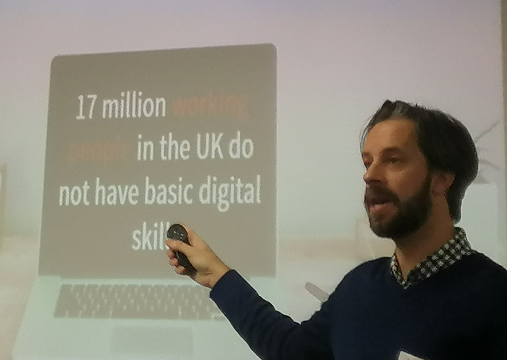
Why is CRM so difficult for Charities
David Scurr of Citizens Online and Becky Smith of Economic Change hosted a morning’s discussion on CRM and the Charity Sector with twenty attendees from various organisations based around the Brighton and Hove area.
Becky is a Salesforce consultant and Economic Change provide an interesting implementation service for Charities and NGOs based around Salesforce where you purchase 6 days consulting time together with 6 free pro-bono days supplied by a trainee on their Supremums scheme where returning-to-work individuals receive Salesforce Training and work experience.
David is heavily involved in third sector digital inclusion in Sussex and revealed that 52% of charities in the UK have no digital strategy. CRM is high on the list of requirements for many charities and the advice is to look at the requirements and the ROI rather than the technical merits of each individual solution.
The relationships often explored with a CRM in the business world are limited to suppliers, customers, agents, and employees. It seems that a typical charity has to deal with a more complex set of relationships. There are the beneficiaries of the charity but also employees, volunteers, freelancers, consultants and mentors who might interact both with the beneficiaries and each other. Members, donors and trustees might be involved with funding and overseeing the charity. Sometimes people might have multiple roles within the charity or perhaps evolve from one role to another and tracking these changing relationships is a challenge for many CRM systems.
Often, the indirect relationships between contacts need to be monitored and can be complex – for example if Jane attends an event with her carer and the carer’s sister donated money through running a marathon and was also the wife of a trustee. These relationships are difficult to store and maintain within a CRM.
Beneficiaries of the charity may be vulnerable people with sensitive data protection issues which need recording in the CRM alongside any case work and contact history. The St Mungo’s Charity, for example, deals with homeless persons and maintains a central Combined Homelessness and Information System (CHAIN) that stores information on vulnerable people which is shared amongst 100 or so homeless charities (all using Salesforce) so that information can be pooled within organisations. Sharing information between organisations (and different CRMs) is a relatively rare feat for multiple CRMs in my experience.
The users of the CRM might include volunteers as well as employees leading to novel licensing requirements and the need for an external website to collect information or to allow volunteers and members to maintain their own information. Airtable seems a popular choice here for sharing information cheaply as does Form Assembly which hosts web forms and integrates with popular systems for a fee. Microsoft are also coming in to this space with spreadsheets shared over mobile phones with PowerApps.
Reporting of outcomes is another area where charities can have trouble extracting the data from a CRM in the appropriate format. There may be multiple projects and multiple outcomes being monitored in any one year and it is difficult to record these in a consistent way to satisfy the reporting requirements for each stakeholder.
Compliance and GDPR are other areas of concern as well as the security of data especially when storing information on potentially vulnerable beneficiaries.
The top tips for a charity considering a CRM implementation is to do a thorough business analysis and look at the costs and return on investment over a multi-year period before creating a feature list and looking at individual solutions. Although there are some low-cost or free licenses available, for example the Open Source CiviCRM, often the data migration and technical implementation will need to be done by an outside company if the technical skills are not available in house (or the technical person has moved on).
Salesforce has attempted to address these complexities with the Non Profit Success Pack (NPSP) add-on pack available to the charity sector. As with all software-as-a-service offerings, the total pricing can be opaque once connectors and third party-apps are included. Salesforce offer the first 10 user licenses for free and then list pricing of $36 or $72 per user per month with free-online training available from Trailhead.
Microsoft CRM has discounted pricing for charity users of around £21.90 per user per month with Team Member licensing from £1.90 a month plus various portals and opportunities to develop your own lo-code applications with PowerApps.
Other schemes also exist, for example, Lloyds Bank Foundation have a scheme of funding up to £2,5000 for a Lamplight implementation.
The consensus seems to be to make the case internally for a CRM looking particularly at the ROI and the specific requirements for your organisation. Have an in-depth look at your requirements and then go out and look at the solutions out there. You will probably need to recruit a consulting organisation along the way to help with precise costing of the solution and to help you decide whether a particular CRM is is a good fit for you. Watch out though – some of the complex relationships and diverse reporting requirements might prevent you from implementing all your requirements without heavy investment.
